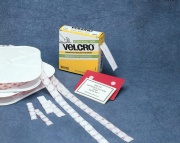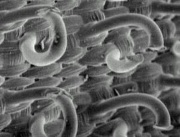Difference between revisions of "Velcro"
| (11 intermediate revisions by the same user not shown) | |||
| Line 2: | Line 2: | ||
== Description == | == Description == | ||
| − | [Velcro USA Inc.] A registered trademark for a reclosable fastener system | + | [Velcro USA Inc.] A registered trademark for a reclosable fastener system developed by George de Mestral, a Swiss inventor, after he closely examined a cocklebur's ability to stick to clothing and fur. Mestral formed Velcro S.A in Switzerland in 1952 and received his first set of patents for Velcro in 1954. Velcro® is a two-component [[nylon_resin|nylon]] system in which one component has hooks and the other has loops. When pressed together, the Velcro® hooks firmly grasp the loops. The two components may be separated by pulling. Velcro® produces various hook designs in order to provide variations in lifetime vs. strength. For example, for two types of hook systems called flexible and molded. The flexible hooks provide maximum cycle life while the molded hooks provide maximum fastening strength with limited cyclability. Velcro® fasteners work effectively in temperatures ranging from -56C (-70F) to 93C (200F). The fasteners may be attached to substrates by sewing, heat sealing or pressure sensitive adhesives. Factory applied pressure-sensitive adhesives can be [[acrylic_adhesive|acrylic]], [[rubber cement|rubber]], or [[polyurethane|polyurethane]] based materials. |
| − | + | ==Synonyms and Related Terms== | |
| − | + | Similar products: TouchTape [TouchTape, Inc.]; Aplix [Aplix, Corp.]; Dura-Grip pads | |
| − | + | == Applications == | |
| − | + | [[File:Velcro hooks_Nanoworld.jpg|thumb|Velcro]] | |
| − | == | + | * Fasteners for packages, containers and rolled items |
| − | + | == Collection Risks == | |
| − | |||
| − | |||
| − | |||
| − | |||
| − | == | ||
| − | + | Nylon becomes brittle when exposed to extremely cold temperatures or ultraviolet light. Any pressure sensitive adhesive should be pH neutral and may fail over time. | |
| + | == Resources and Citations == | ||
| + | * Velcro: [https://www.velcro.com/ Website] | ||
| + | * K.Leath, M.Brooks "Velcro and other Hook and Loop Fasteners: A Preliminary Study of Their Stability and Ageing Characteristics", TCN p.5-11. | ||
| + | * Rachael Perkins Arenstein, Lisa Goldberg, and Eugenie Milroy, ‘Support and Rehousing for Collection Storage’ In ‘Preventive Conservation: Collection Storage’ Lisa Elkin and Christopher A. Norris (eds.), Society for the Preservation of Natural History Collections, New York. 2019. | ||
| + | * Hermann Kuhn, ''Conservation and Restoration of Works of Art and Antiquities'', Butterworths, London, 1986 | ||
* ''Caring for your Collections'', Arthur W Schulz (ed.), Harry N. Abrams, Inc. , New York, 1992 | * ''Caring for your Collections'', Arthur W Schulz (ed.), Harry N. Abrams, Inc. , New York, 1992 | ||
| − | |||
* ''Fairchild's Dictionary of Textiles'', Phyllis G.Tortora, Robert S. Merkel (eds.), Fairchild Publications, New York City, 7th edition, 1996 | * ''Fairchild's Dictionary of Textiles'', Phyllis G.Tortora, Robert S. Merkel (eds.), Fairchild Publications, New York City, 7th edition, 1996 | ||
| − | + | * Meredith Montague, contributed information, 1998 | |
| − | * | + | * Teri Hensick, contributed information, 1998 |
| − | + | * Website: www.hants.org.uk/museums/ofr/cmeth_t.html | |
| − | * | + | * AMOL reCollections Glossary at http://amol.org.au/recollections/7/c/htm |
| − | |||
| − | * Website | ||
| − | |||
| − | * | ||
| − | |||
| − | [[Category:Materials database]] | + | [[Category:Materials database]][[Category:MWG]][[Category:Physical Fastener]] |
Latest revision as of 12:08, 28 July 2024
Description
[Velcro USA Inc.] A registered trademark for a reclosable fastener system developed by George de Mestral, a Swiss inventor, after he closely examined a cocklebur's ability to stick to clothing and fur. Mestral formed Velcro S.A in Switzerland in 1952 and received his first set of patents for Velcro in 1954. Velcro® is a two-component nylon system in which one component has hooks and the other has loops. When pressed together, the Velcro® hooks firmly grasp the loops. The two components may be separated by pulling. Velcro® produces various hook designs in order to provide variations in lifetime vs. strength. For example, for two types of hook systems called flexible and molded. The flexible hooks provide maximum cycle life while the molded hooks provide maximum fastening strength with limited cyclability. Velcro® fasteners work effectively in temperatures ranging from -56C (-70F) to 93C (200F). The fasteners may be attached to substrates by sewing, heat sealing or pressure sensitive adhesives. Factory applied pressure-sensitive adhesives can be acrylic, rubber, or Polyurethane based materials.
Synonyms and Related Terms
Similar products: TouchTape [TouchTape, Inc.]; Aplix [Aplix, Corp.]; Dura-Grip pads
Applications
- Fasteners for packages, containers and rolled items
Collection Risks
Nylon becomes brittle when exposed to extremely cold temperatures or ultraviolet light. Any pressure sensitive adhesive should be pH neutral and may fail over time.
Resources and Citations
- Velcro: Website
- K.Leath, M.Brooks "Velcro and other Hook and Loop Fasteners: A Preliminary Study of Their Stability and Ageing Characteristics", TCN p.5-11.
- Rachael Perkins Arenstein, Lisa Goldberg, and Eugenie Milroy, ‘Support and Rehousing for Collection Storage’ In ‘Preventive Conservation: Collection Storage’ Lisa Elkin and Christopher A. Norris (eds.), Society for the Preservation of Natural History Collections, New York. 2019.
- Hermann Kuhn, Conservation and Restoration of Works of Art and Antiquities, Butterworths, London, 1986
- Caring for your Collections, Arthur W Schulz (ed.), Harry N. Abrams, Inc. , New York, 1992
- Fairchild's Dictionary of Textiles, Phyllis G.Tortora, Robert S. Merkel (eds.), Fairchild Publications, New York City, 7th edition, 1996
- Meredith Montague, contributed information, 1998
- Teri Hensick, contributed information, 1998
- Website: www.hants.org.uk/museums/ofr/cmeth_t.html
- AMOL reCollections Glossary at http://amol.org.au/recollections/7/c/htm

